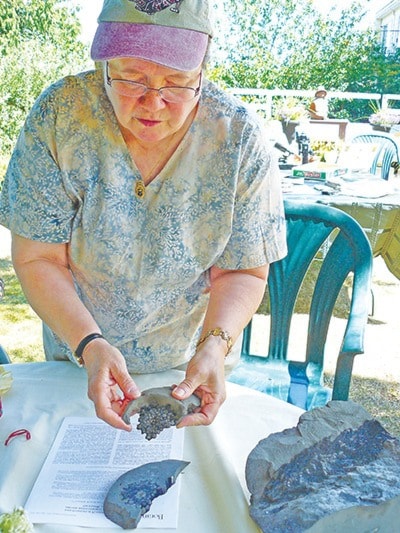As one would expect with internationally-renowned scientists, Dr. Ruth Stockey and Dr. Gar Rothwell jet all over the world to carry out their research.
One trip might take them to fossil beds in Peru, another to a dig in Argentina, another might be to a symposium in Japan and yet another would be to Graham and Tina Beard’s back yard.
The two renowned paleontologists from the University of Oregon don’t go to Argentina every year, but they make a point not to miss their annual trip to this part of the world.
The pair, flanked by a team of graduate students from all over the globe, were at the Beard’s Qualicum Beach home this week, using his back yard as a base camp while they perused various finds from the area.
The finds, said Dr. Stockey, are many and various, which is not surprising, considering both central and northern Vancouver Island hold world-class fossil beds. As well, each slice of rock Beard shows them has hundreds of small fossils inside.
There are no tyranosaurus teeth or velociraptor bits included however. These fossils come from the Eocene — the age of horses — about 45 million years ago, when all the dinosaurs were long extinct.
That said, the tiny fossils of ferns, pollen, nuts and seeds are important, Rothwell said, and fascinating to those who know what they’re looking for.
“We are interested in the pattern of the evolution of life,” he said. “These are the intermediates. The fossil record contains about 99 per cent of all the species that ever lived, compared to the one per cent that’s alive today. We’re looking at the 99 per cent.”
Graham Beard agreed.
“The Eocene was the time when the flowering plants and grasses were just getting going, so it’s a very important time,” he said.
Besides the Beards, the researchers visit a great many other fossil hounds in the area, who scour sites at secret Campbell River, Hornby Island and north Island locations.
The tally has been impressive. Over the 15 years the scientists have been visiting Qualicum Beach they have seen over a dozen scientific papers published about the area’s fossils, among them at least one PhD thesis.
Finds have included the earliest known species of spruce — a find that back-dated its evolution by about 100 million years. As well, they discovered a whole new genus of walnut — Beardii Vancouverensis — named after its discoverer, Graham Beard.
Some of the seeds and cones they find, like the spruce, are similar to species found on Vancouver Island today, but many of them are not. There’s a good reason for that. Back in the Eocene, the climate was much warmer than it is today, so tree ferns and broad-leafed tropical plants — such as one might find in Borneo or Malaysia today — were the norm.
One discovery they made involved sexuality.
“There’s one quarry near Mt. Washington where they found a plantinoid that was bisexual,” Stockey said. “That family has a pretty good fossil record and while all the living plants are unisexual, with a female head and a male pollen-producing head, this one had a both pollen and seed producing structures on the same head.”
The plantinoids, deciduous plants with palmate, veined leaves were once dominant in the area but are now only represented by a few species, such as the sumac, one of which is located outside Qualicum Foods in Qualicum Beach.
The two scientists have worked together for many years, starting their collaboration at the University of Alberta, where they both taught for many years. During that time they have agreed on many findings and disagreed on others — sometimes strenuously — but as they pack up their boxes of specimens for the long drive home, both Stockey and Rothwell smile and laugh a lot. There’s a couple of good reasons for that.
First, the trip has once again been productive, with many slices of rock identified and catalogued for future study. As well, they simply enjoy what they’re doing.
“We do this because we’re having a good time,” Rothwell said. “If we didn’t do this we would have to get a real job.”
